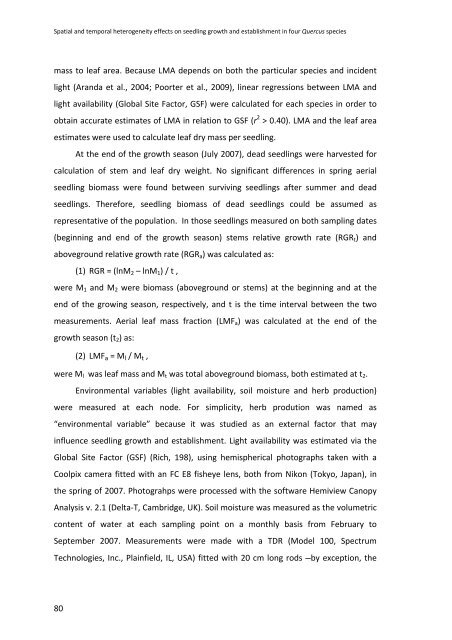Establecimiento de cuatro especies de Quercus en el sur de la ...
Establecimiento de cuatro especies de Quercus en el sur de la ...
Establecimiento de cuatro especies de Quercus en el sur de la ...
Create successful ePaper yourself
Turn your PDF publications into a flip-book with our unique Google optimized e-Paper software.
Spatial and temporal heterog<strong>en</strong>eity effects on seedling growth and establishm<strong>en</strong>t in four <strong>Quercus</strong> species<br />
mass to leaf area. Because LMA <strong>de</strong>p<strong>en</strong>ds on both the particu<strong>la</strong>r species and inci<strong>de</strong>nt<br />
light (Aranda et al., 2004; Poorter et al., 2009), linear regressions betwe<strong>en</strong> LMA and<br />
light avai<strong>la</strong>bility (Global Site Factor, GSF) were calcu<strong>la</strong>ted for each species in or<strong>de</strong>r to<br />
obtain accurate estimates of LMA in r<strong>el</strong>ation to GSF (r 2 > 0.40). LMA and the leaf area<br />
estimates were used to calcu<strong>la</strong>te leaf dry mass per seedling.<br />
At the <strong>en</strong>d of the growth season (July 2007), <strong>de</strong>ad seedlings were harvested for<br />
calcu<strong>la</strong>tion of stem and leaf dry weight. No significant differ<strong>en</strong>ces in spring aerial<br />
seedling biomass were found betwe<strong>en</strong> <strong>sur</strong>viving seedlings after summer and <strong>de</strong>ad<br />
seedlings. Therefore, seedling biomass of <strong>de</strong>ad seedlings could be assumed as<br />
repres<strong>en</strong>tative of the popu<strong>la</strong>tion. In those seedlings mea<strong>sur</strong>ed on both sampling dates<br />
(beginning and <strong>en</strong>d of the growth season) stems r<strong>el</strong>ative growth rate (RGR t ) and<br />
aboveground r<strong>el</strong>ative growth rate (RGR a ) was calcu<strong>la</strong>ted as:<br />
(1) RGR = (lnM 2 – lnM 1 ) / t ,<br />
were M 1 and M 2 were biomass (aboveground or stems) at the beginning and at the<br />
<strong>en</strong>d of the growing season, respectiv<strong>el</strong>y, and t is the time interval betwe<strong>en</strong> the two<br />
mea<strong>sur</strong>em<strong>en</strong>ts. Aerial leaf mass fraction (LMF a ) was calcu<strong>la</strong>ted at the <strong>en</strong>d of the<br />
growth season (t 2 ) as:<br />
(2) LMF a = M l / M t ,<br />
were M l was leaf mass and M t was total aboveground biomass, both estimated at t 2 .<br />
Environm<strong>en</strong>tal variables (light avai<strong>la</strong>bility, soil moisture and herb production)<br />
were mea<strong>sur</strong>ed at each no<strong>de</strong>. For simplicity, herb prodution was named as<br />
“<strong>en</strong>vironm<strong>en</strong>tal variable” because it was studied as an external factor that may<br />
influ<strong>en</strong>ce seedling growth and establishm<strong>en</strong>t. Light avai<strong>la</strong>bility was estimated via the<br />
Global Site Factor (GSF) (Rich, 198), using hemispherical photographs tak<strong>en</strong> with a<br />
Coolpix camera fitted with an FC E8 fisheye l<strong>en</strong>s, both from Nikon (Tokyo, Japan), in<br />
the spring of 2007. Photograhps were processed with the software Hemiview Canopy<br />
Analysis v. 2.1 (D<strong>el</strong>ta‐T, Cambridge, UK). Soil moisture was mea<strong>sur</strong>ed as the volumetric<br />
cont<strong>en</strong>t of water at each sampling point on a monthly basis from February to<br />
September 2007. Mea<strong>sur</strong>em<strong>en</strong>ts were ma<strong>de</strong> with a TDR (Mo<strong>de</strong>l 100, Spectrum<br />
Technologies, Inc., P<strong>la</strong>infi<strong>el</strong>d, IL, USA) fitted with 20 cm long rods ─by exception, the<br />
80

















